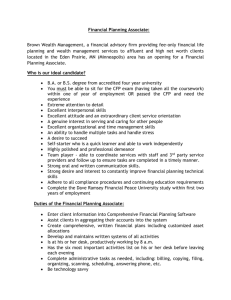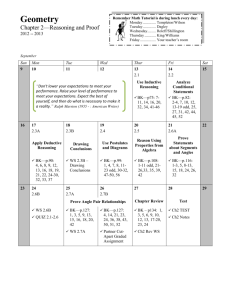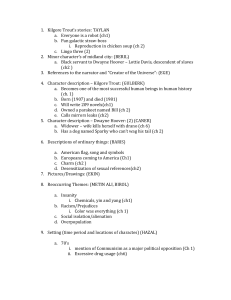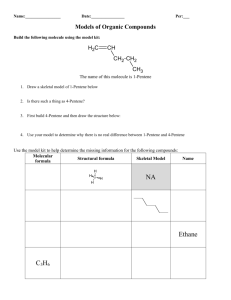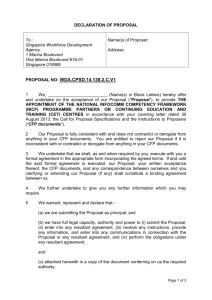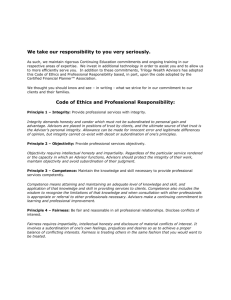Planning Perspectives
advertisement
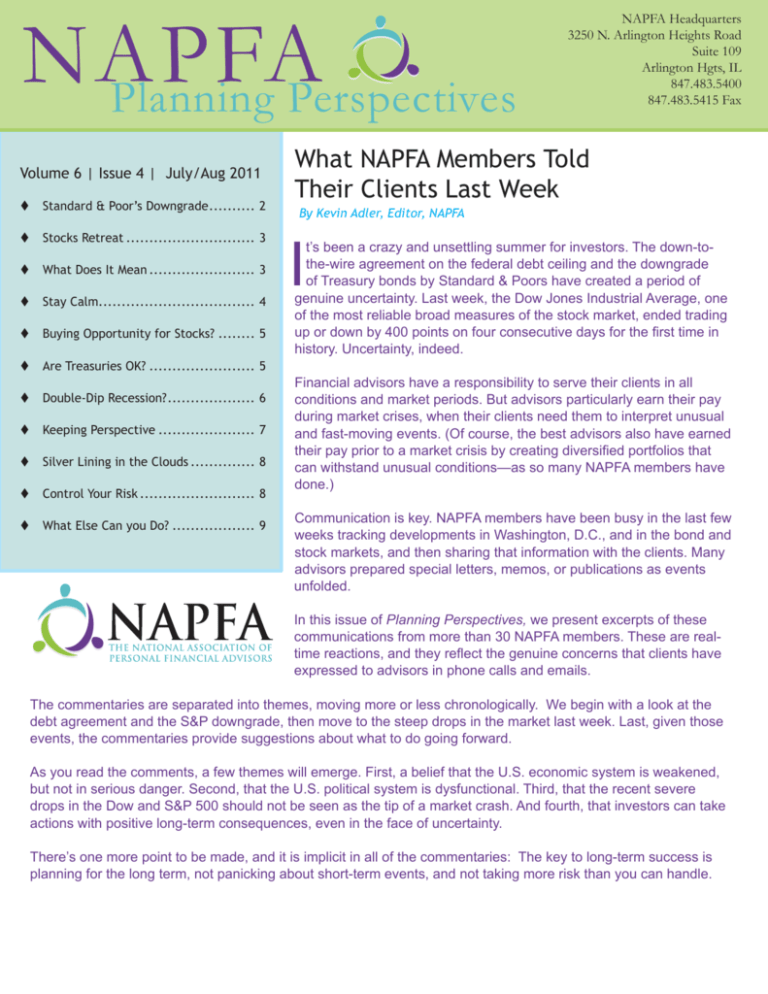
NAPFA Planning Perspectives Volume 6 | Issue 4 | July/Aug 2011 Standard & Poor’s Downgrade .......... 2 Stocks Retreat ............................ 3 What Does It Mean ....................... 3 Stay Calm.................................. 4 Buying Opportunity for Stocks? ........ 5 Are Treasuries OK? ....................... 5 Double-Dip Recession? ................... 6 Keeping Perspective ..................... 7 Silver Lining in the Clouds .............. 8 Control Your Risk ......................... 8 What Else Can you Do? .................. 9 NAPFA Headquarters 3250 N. Arlington Heights Road Suite 109 Arlington Hgts, IL 847.483.5400 847.483.5415 Fax What NAPFA Members Told Their Clients Last Week By Kevin Adler, Editor, NAPFA I t’s been a crazy and unsettling summer for investors. The down-tothe-wire agreement on the federal debt ceiling and the downgrade of Treasury bonds by Standard & Poors have created a period of genuine uncertainty. Last week, the Dow Jones Industrial Average, one of the most reliable broad measures of the stock market, ended trading up or down by 400 points on four consecutive days for the first time in history. Uncertainty, indeed. Financial advisors have a responsibility to serve their clients in all conditions and market periods. But advisors particularly earn their pay during market crises, when their clients need them to interpret unusual and fast-moving events. (Of course, the best advisors also have earned their pay prior to a market crisis by creating diversified portfolios that can withstand unusual conditions—as so many NAPFA members have done.) Communication is key. NAPFA members have been busy in the last few weeks tracking developments in Washington, D.C., and in the bond and stock markets, and then sharing that information with the clients. Many advisors prepared special letters, memos, or publications as events unfolded. In this issue of Planning Perspectives, we present excerpts of these communications from more than 30 NAPFA members. These are realtime reactions, and they reflect the genuine concerns that clients have expressed to advisors in phone calls and emails. The commentaries are separated into themes, moving more or less chronologically. We begin with a look at the debt agreement and the S&P downgrade, then move to the steep drops in the market last week. Last, given those events, the commentaries provide suggestions about what to do going forward. As you read the comments, a few themes will emerge. First, a belief that the U.S. economic system is weakened, but not in serious danger. Second, that the U.S. political system is dysfunctional. Third, that the recent severe drops in the Dow and S&P 500 should not be seen as the tip of a market crash. And fourth, that investors can take actions with positive long-term consequences, even in the face of uncertainty. There’s one more point to be made, and it is implicit in all of the commentaries: The key to long-term success is planning for the long term, not panicking about short-term events, and not taking more risk than you can handle. What happened......... and what to do about it. S&P Downgrade Our nation is our household, and we have overspent our household budget. All the people in Washington are to blame for the country’s poor balance sheet, and we, as voters, put them there. — John Gugle, CFP®, CRPC®, Alpha Financial Advisors, LLC, Charlotte, NC Whatever criticism you hear of S&P is beside the point. S&P is right, and the downgrade is long overdue. The U.S. is and has been living beyond its means for many years and is projected to continue doing so. The downgrade is a reflection not of our ability to pay, but whether our elected officials can come together and move the country forward. — Eric J. McClain, CFP®, Wesban Financial Consultants, P.C., Birmingham, AL We may indeed have the makings for a new sit-com, where Congress and Standard & Poor’s are next-door neighbors who constantly try to outsmart one another and get in each other’s hair, but who almost always see their efforts backfire. — Dennis Stearns, CFP®, ChFc, Stearns Financial Services Group, Inc., Greensboro, NC [Federal deficit] cuts were much lower than either party initially agreed were necessary, revenues were not even discussed, and no cuts were offered for Medicare, Social Security, or Medicaid. This is simply an intractable situation, and my hope is the S&P downgrade will provide the additional pressure necessary to make some long-term decisions for the benefit of our economy. — Brian O’Neill, CFP®, Cahaba Wealth Management, Inc., Atlanta www.NAPFA.org Standard & Poor’s delivered on its longstanding threat to downgrade our U.S. Treasury’s long-term debt rating. Its reasoning was broadcast well in advance, but ignored by politicians who have now gone on vacation and are in the process of trying to shoot the messenger. The American public deserves better: a straightforward discussion of the issues and a remedial plan. The Simpson-Bowles Committee Report recommendations would be a blueprint providing cover for most [politicans]; the grand design all parties seem to be seeking but afraid to endorse. There is enough blame for the mess we find ourselves in for all to share. S&P’s downgrade is a symptom of U.S. failure to confront our fiscal problems, not the cause of the global market malaise. — James L. Joslin, CFP®, and Corey Peterson, CFP®, TFC Financial Management, Boston Standard Bearer for the Profession - Champion for the Public - Beacon for Objective Financial Advisors 2 What happened......... and what to do about it. What Does it Mean? The economic news is nothing new: Investors are fearful of another U.S. recession, as well as looking at continued weakness in European countries. This shows us just how fickle investors can be by reacting to short-term news at seemingly random times. — David Strege, CFA, CFP®, and Lance Gunkel, CFA, CFP®, Syverson Strege & Company, West Des Moines, IA The most practical consequence of this downgrade is a crumbling of the facade that all is well. For some years now, our firm (and many other market observers) has noted the overall economy is in secular decline, despite claims by the Administration and other large players to the contrary. In addition we have noted the U.S. dollar is on increasingly shaky ground on the international stage, and this downgrade has served as a sounding board for countries like China to call for an end to the U.S. dollar era as the world’s reserve currency. Uncertainty is likely to increase, as the political instability noted by S&P is very real. During this time, patient investors can be rewarded by selectively buying fundamentally strong, dividendpaying equities, while a majority of stocks have become undervalued. Ample cash reserves are also a must to securely ride out the storm. — Emily C. Sanders, CPA, RFG, MBA, Sanders Financial Management, Inc., Norcross, GA We’ve experienced a global selloff in stocks and commodities, as investors fled from assets that could be hurt by a new recession. This is not a direct result of the standoff in Congress over the debt ceiling. However, the congressional bickering and the talk about the U.S. defaulting on its debts created “crisis fatigue” and contributed heavily to a loss of investor confidence. — Rhonda Holifield, CFP®, CCPS, and Helen Huntley, BS, MA, Holifield Huntley Financial Advisers, St. Petersburg, FL We believe that the current market decline is a symptom of a crisis of confidence. There is enormous anxiety about global sovereign debt and the ineffectiveness that governments have shown in resolving their fiscal problems and reacting to events. Evidencing this position, Standard and Poor’s downgrade opinion said, in part, that “elected officials remain wary of tackling the structural issues required to effectively address the rising U. S. public debt burden in a manner consistent with a ‘AAA rating.’” Again, this is not really news, but this sort of political stalemate clearly detracts from investors’ confidence in the future. — Larry E. Maddox, CFA, CFP®, Horizon Advisors, LLC, Houston High deficit spending, growing woes among the Eurozone countries, increasing global interdependence, and a continued lack of confidence in the economy and willingness to spend by both businesses and individuals have all contributed to where we are today. And all signs point toward continued economic weakness for some time. — Deidra Fulton, CFP®, Fulton Financial Planning, Inc., Plano, TX www.NAPFA.org Stocks Retreat Standard Bearer for the Profession - Champion for the Public - Beacon for Objective Financial Advisors 3 What happened......... and what to do about it. Stay Calm We’re better off focusing on what we can control in our lives. What happens on Wall Street is truly beyond your control or mine. — Kathleen Rehl, Ph.D., CFP®, Rehl Financial Advisors, Land O’Lakes, FL Historically, approximately one of every five years has resulted in negative returns for the investment markets. The stock markets have always recovered and have proved to be one of the best long-term investment opportunities for investors with a plan. — Eric A. Mote, CFP® & Jean Mote, CFP®, Mote Wealth Management, LLC, Cedar Rapids, IA We still do not see this as a 2008 fall similar to what happened when Lehman Brothers declared bankruptcy. The markets still work. Credit is available, and the banking system continues to function. However, the losses are severe and are approaching points where we will consider, in appropriate instances, taking defensive actions. — Roger Southward, CFP®, MPA, Southward Financial Services, LLC, Pickerington, OH The question on everyone’s mind right now is: What to do about it? Sell everything and run to the nearest gold dealer? Just get everything in cash and put it under the mattress? I recommend neither. In fact, I recommend you not make any dramatic moves. Right now, your account statements are reflecting the drop in market value. However, this is a “paper loss” only. If you were to sell right now, you will be locking in real loss. — Andy Tilp, MS, Trillium Valley Financial Planning, LLC, Sherwood, OR www.NAPFA.org I know it’s painful to watch the market fall into correction territory yet again. It is important to keep a level head and remember that you are in a well-balanced, diversified portfolio suited to your time horizon, risk tolerance, and goals. I don’t know what the market will do today, next week, or next month, but I do know what it does historically over long periods of time— and that’s where we have to maintain our focus. I read this morning in The Wall Street Journal that 80 percent of the S&P 500 companies reported quarterly earnings that were positive. Many companies have very strong cash positions and are raising dividends. — Brenda Knox, CFP®, Financial Elements, Inc., Rolling Meadows, IL Standard Bearer for the Profession - Champion for the Public - Beacon for Objective Financial Advisors 4 What happened......... and what to do about it. Buying Opportunity for Stocks? This appears to be a classic emotion-driven downturn, made worse by a breathless media that always seems to amplify the mood of the moment. History has shown that these times of panic are fundamentally an invitation to sell at a market bottom to somebody with a clearer head and stronger nerves. — P.J. DiNuzzo, CPA/PFS, MSTx, MBA, DiNuzzo Investment Advisors, Inc., Beaver, PA Market volatility provides investment opportunities. Somehow we easily understand this when furniture goes on sale. But it doesn’t feel good to apply the same rationale to our investments; yet we must discipline ourselves to do so. — Constance A. Stone, CFP®, ATP™, Stepping Stone Financial, Inc., Chagrin Falls, OH There is some real risk in the market, but not in this country. Europe is where the United States was a couple of years ago: The banks are in terrible shape, and the European Central Bank and European Union are trying to figure out who to bail out and how. They may figure it out and get a spirited rally, but they could also not get it right and suffer. But other areas, especially after this sell-off, are looking very attractive. — Ross Levin, CFP®, Accredited Investors, Inc., Edina, MN [The market has reached] an 18 percent decline in the stock market from its highs earlier this year … [which is] not uncommon. The average intra-year drop in the S&P 500 since 1980 is 14.3 percent. — Carl Camp, CFP®, Eclectic Associates, Inc., Fullerton, CA Are Treasuries OK? With regard specifically to our strategy of using Treasury Strips to build bond ladders for those of you entering or in retirement, I see no reason for chang[e]. The reality is that these investments remain the safest in the world, as evidenced by their continued high demand throughout the debt-limit crisis and subsequent stock market drops. My conviction remains that holding these to maturity to fund your retirement cash flow needs is a prudent strategy that will serve you well throughout your retirement years. — Joe Alfonso, CFP®, ChFc, EA, Aegis Financial Advisory, Lake Oswego, OR This may be hard to believe, but the only investment going up is U.S. Treasuries! Smart people … have solid bond ladders, particularly if they are retired. This is the bedrock of safety which is the result of longterm, patient financial planning. If we slide into long-term deflation, this is your only safe haven. — Bert Whitehead, JD, MBA, Cambridge Connection, Inc., St. Cloud, FL www.NAPFA.org This correction is not based on economic fundamentals, which have been improving (albeit glacially slow); rather, fundamentals are out, and pure emotion drove the sell-off over the past few days. As a nation, we are not in any meaningfully different place than two weeks ago. Our equity managers are capitalizing on the opportunities this mini-correction presents—giving them opportunities to load up on high-quality stocks at discount prices. In short: The market is vastly oversold at this point. I would not be surprised to see it pop back up over the next few weeks. — Eric J. McClain, CFP®, Wesban Financial Consultants, P.C., Birmingham, AL Standard Bearer for the Profession - Champion for the Public - Beacon for Objective Financial Advisors 5 What happened......... and what to do about it. Double-Dip Recession? We are not headed for a double-dip recession. Actually, the opposite is happening, but not as rapidly as we all are hoping. Here are some economic facts that point to a continued recovery: • Unemployment is going down. Private sector payrolls have increased by an average of 150,000/month over the last year. • Average hourly wages are up 3.5 percent (annualized) over the last three months. • Corporate earnings (reflected by companies in the S&P 500) are up 20 percent over the last year. • Vehicle sales were up 6.9 percent in July over June. • Retail store sales were up 4.6 percent in July, or up 2.8 percent over last 12 months. • Manufacturing has been expanding for 24 consecutive months. • Productivity has improved over the last 12 months by 0.8 percent. — Stephen Madeyski, CFP®, MBA, Stephen Madeyski Financial Planning, Albuquerque, NM and/or Congress does something to reassure the markets, it will need to benefit the market until at least November 2012. No one in the current administration is going to approve something that could run out in the middle of campaign season. That’s why, historically, the two years prior to a first-term president’s reelection have almost always been good for the market. The two years following a reelection is another story. Given this, I don’t think we are headed into a second recession prior to the 2012 election, and there is reason to be cautiously optimistic without being labeled crazy. After that, all bets are off. — Jerry Verseput, CFP®, Veripax Financial Management, El Dorado Hills, CA www.NAPFA.org The Federal Reserve is essentially out of bullets, and there is no appetite in Congress for further fiscal stimulus. As a result, the risks of another recession later this year or in 2012 have increased quite a bit. — S. Andrew Claybrook, CPA/PFS, CFP®, CMFC, Fee-Only Financial Planning Solutions, P.C., Franklin, TN My mid-range view: Assuming that the Fed Standard Bearer for the Profession - Champion for the Public - Beacon for Objective Financial Advisors 6 What happened......... and what to do about it. Keeping Perspective by Joe Taylor, Oak Street Advisors, Myrtle Beach, SC Countries with AAA rating GDP (Billions) Public Debt United States $14,720.00 8,670.00 Public Debt as % of GDP 58.9% Australia $ 889.60 $ 332.90 $1,335.00 $ 204.10 $ 185.40 $2,160.00 $2,951.00 $ 680.40 $ 199.27 $ 234.36 $ 453.90 $ 88.99 $ 89.73 $1,814.40 $2,213.25 $ 439.54 22.4% 70.4% 34.0% 43.6% 48.4% 84.0% 75.0% 64.6% $ 276.40 $ 292.20 $ 354.00 $ 236.90 $2,189.90 $ 131.84 $ 299.21 $ 144.43 $ 130.76 $1,674.59 47.7% 102.4% 40.8% 40.0% 76.5% $12,176.90 $7,914.27 65.0% Austria Canada Denmark Finland France Germany The Netherlands Norway Singapore Sweden Switzerland United Kingdom Total, except U.S. www.NAPFA.org This chart shows that the United States’ GDP is greater than the GDP of all other AAArated countries combined. The U.S. debt as a percentage of GDP is less than the weighted average of all those other countries and is about the midpoint of this group. Now, ask yourself, which of these counties you would trust more than the U.S. to lend your money to. Standard Bearer for the Profession - Champion for the Public - Beacon for Objective Financial Advisors 7 What happened......... and what to do about it. One last fact regarding recent government debt downgrades from AAA status in Canada, Australia, and Japan: The downgrades did not result in an increase in borrowing costs in the short or medium term. For Canada and Australia, it did result in the coming together of political parties to right their fiscal ships. Further, it did lead to the strengthening of their currencies. Let us hope for the same result in the U.S.A. While the timing could not be worse, given the weak economic data, the S&P move could prove to be beneficial in the long run if the downgrade becomes a catalyst for genuine change in Washington. — Ian Boyce, CFP®, Dickmeyer Boyce Financial Management, Inc., Fort Wayne, IN This weekend’s extraordinary events point to a possible silver lining. The heavily indebted European countries, as well as the U.S., are being forced by the markets to address their gaping budget deficits—something their political leaders have been unwilling or unable to do. This would be a long-term positive for the markets. — Craig Larsen, CFP®, ChFC, AHC Advisors, Inc., St. Charles, IL Control Your Risk Reality is, any time is an uncertain time. We can never know when the next crisis is right around the corner. Some crises, like the savings and loan crisis and the most recent economic crisis, were manmade. I’m pretty certain there are going to be more of these. My point is, we always have to invest as if there is going to be trouble in the nottoo-distant future. While we can hope for the best, we have to plan for the worst. We can’t take on too much risk, no matter which forecaster is predicting smooth sailing for X number of years. No one can predict the next recession, the next massive layoff, or the next oil-rich country to have its government overthrown. — Karl Leal, AAMS, CRPC, ADPA, Leal Financial Planning, Campbell, CA We lean toward expecting inflationfriendly policies from our government. As the world’s biggest debtor, the U.S. would enjoy repaying with a devalued currency. Our fear is that once undertaken, inflation may not be all that easy to control. There is also the risk that loose money may sit in sterile reserves (as has been the case this year) and fail to prevent deflation. In such a case, investments made because of inflation concerns could prove disastrous. — J. Michael Martin, CFP®, JD, Financial Advantage, Inc., Columbia, MD www.NAPFA.org Silver Linings in the Clouds? Standard Bearer for the Profession - Champion for the Public - Beacon for Objective Financial Advisors 8 What happened......... and what to do about it. What Else Can You Do? By Lea Ann Garrison Knight, CFP® Garrison Knight Financial Planning LLC, Bedford, MA 1. I am making sure I have six months of living expenses in cash. I don’t want to be liquidating my investments while the market is on a roller-coaster ride. Trying to time the market in and out right now is a perilous exercise. 2. I am reminding myself that I will not need most of my invested assets for another 20 years. This is LONG TERM money. Over longer periods of time, in any rolling 20year period, the equity markets outperform any other place I could park that money. Even though I’m not retired yet, this concept is still true for those of you who are retired. 3. I know that we are going into a period of rising inflation. Historically, the inflation rate has been 3 percent. It will probably go up from there; in fact, one could argue on certain goods (like oil and food), it already has. The only way to outpace inflation is to keep long-term money invested in the equity markets. 4. I will keep funding my retirement accounts, my college savings accounts, and my discretionary savings. If the market is down, I’m buying cheaply. If the market is up, my existing balances increase. Either way, I’m building a nest egg for the long term. If you stayed in the market after the 2008 crash, your S&P portfolio was up 30 percent over the last year alone. 5. I am making sure I have plenty of dividend-paying stocks. Companies are hoarding cash right now in anticipation of higher interest rates and more restrictive borrowing limits. But at some point they will be forced to start using that cash to expand, hire, and increase their dividends. They were on the cusp of doing this before the threat of the S&P downgrade. Once this crisis passes, they will start spending again. 6. I am minimizing my debt. Frankly, I should be doing that anyway, but we are about to see an increase in interest rates and further tightening of borrowing requirements. 7. I am making sure I have at least 20 percent of my investments outside the U.S. This should provide some downside protection to a weakening dollar and gyrations in the U.S. economy. I can’t control what happens in Washington or what the folks at S&P decide to do. Nor can I predict what the markets will really do in response. But after 25 years watching the markets go up and down, I am staying in, staying focused on my goals, and staying positive on the long-term future of U.S. companies. And I’m sleeping well each night. www.NAPFA.org I ’ve received many calls the last couple of weeks about what, if anything, an individual investor should be doing differently given the current state of affairs in Washington. All politics aside, these are worrisome times. So, here are my suggestions on how to think about this current crisis. I’m not an economist or a political junkie, for that matter. I could be wrong. But I’m also an individual investor, and here’s how I’m handling this situation: Standard Bearer for the Profession - Champion for the Public - Beacon for Objective Financial Advisors 9

